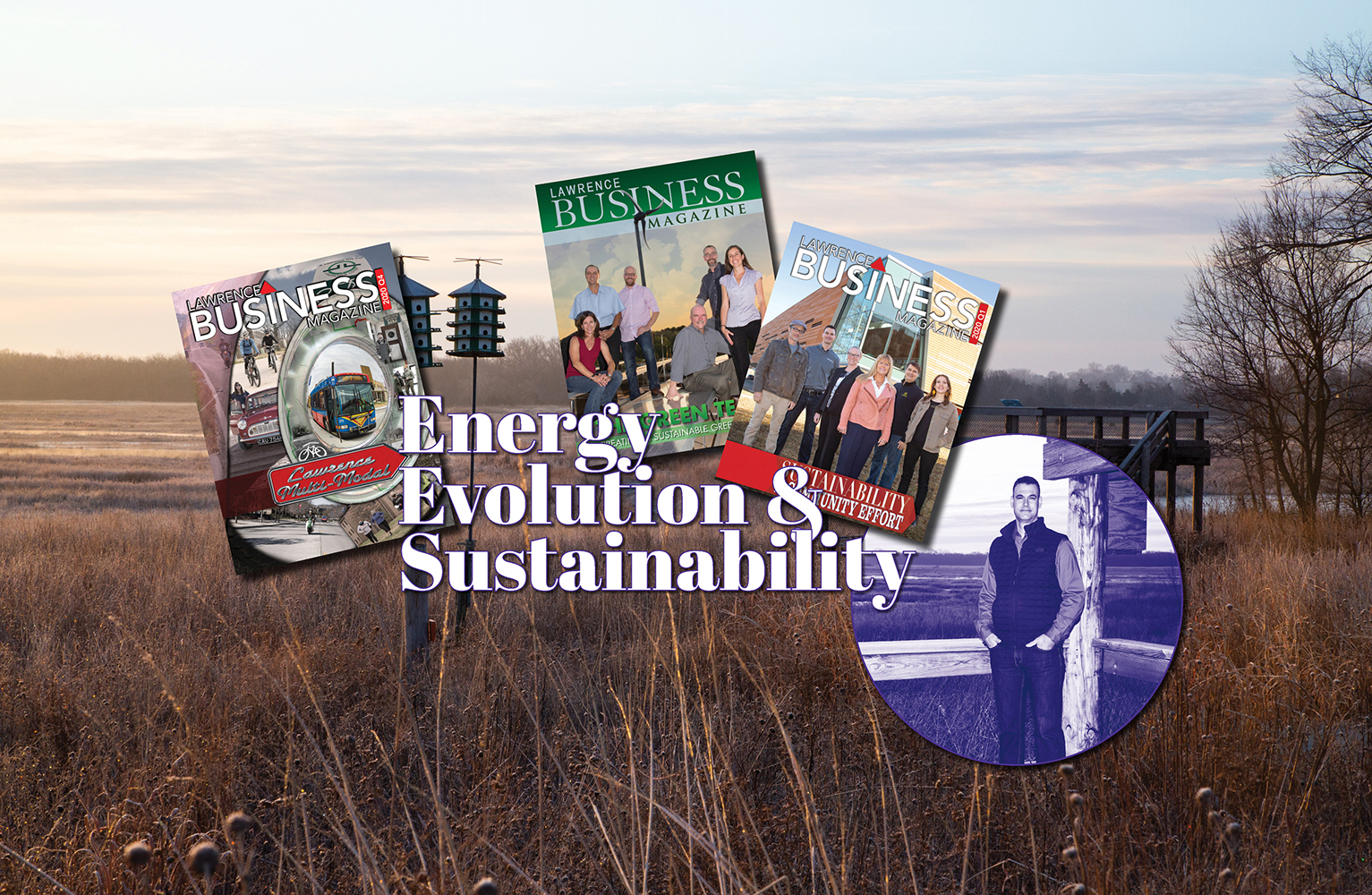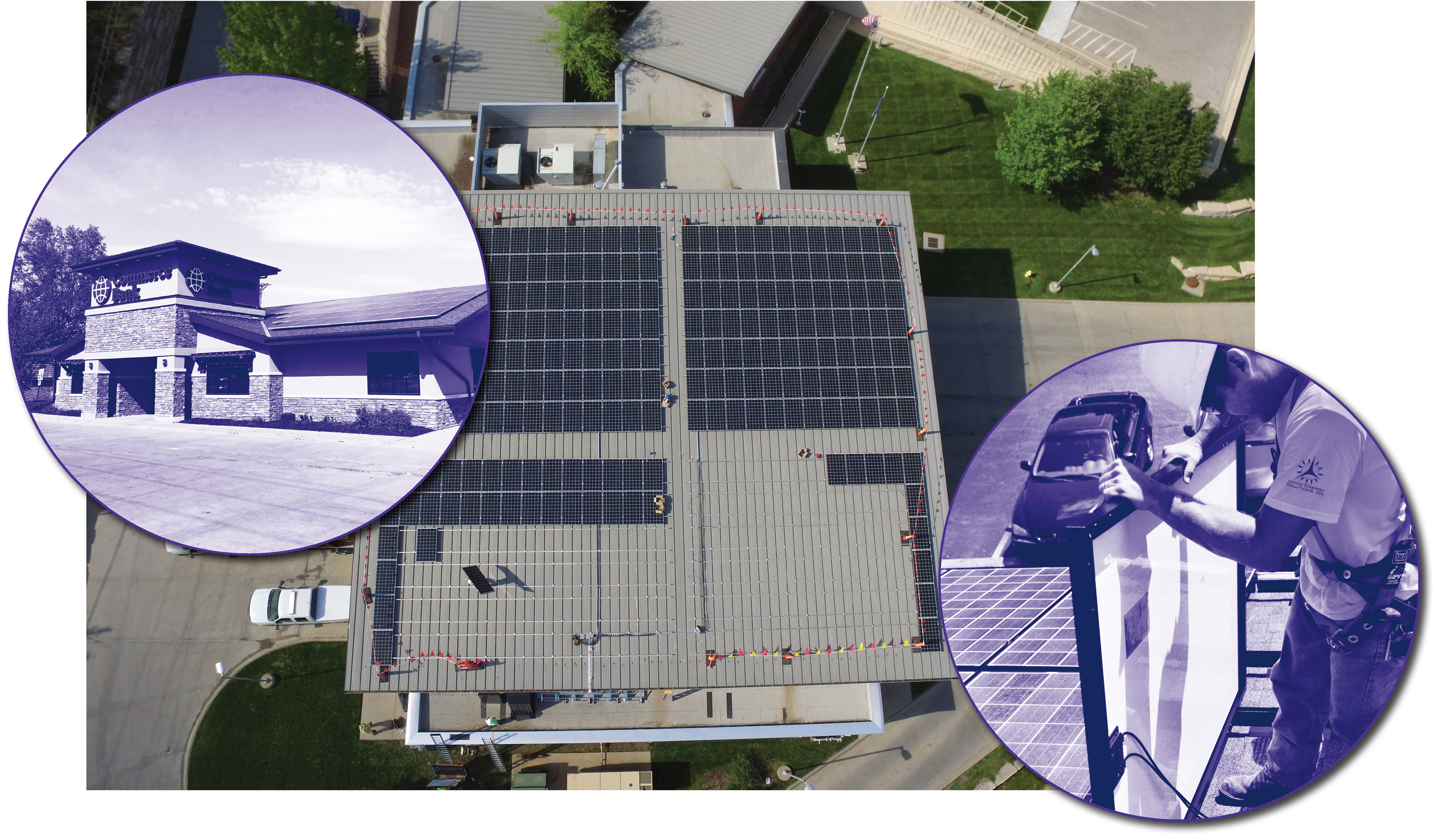HEAD: Energy Evolution and Sustainability
By Bob Luder, photos by Steven Hertzog
| story by | |
| photos by | Steven Hertzog |
| OPEN A PDF OF THE ARTICLE |
Lawrence and Douglas County are ahead of the curve when it comes to the awareness, popularity, engagement, and execution of sustainability practices.

LBM Covers, Multi-Modal (2020Q4), The Green Team (2013Q3) and Sustainability, a Community Effort (2020Q1); The Baker Wetlands and Ben Postlethwait, (2020Q1)
Sustainability is one of those nebulous terms that can take on various definitions depending on the context in which it’s being considered.
Perhaps most widely addressed and debated these days is environmental sustainability—expanding the use of clean, renewable energy and improving the quality of the environment in terms of cleaner air, water and land, leading to a more livable environment for future generations. But there’s also social sustainability, which promotes well-being within organizations’ workforces by establishing greater diversity, equity and inclusion within those workforces. And there’s governmental sustainability, which involves company leaders working closely with state and local politicians to enact environmentally friendly legislation that promotes sustainable practices.
Of course, it all goes hand in hand within the overarching narrative of what is sustainable and what will leave Mother Earth a better place to grow and live for our descendants.
One aspect of sustainability that looms as a commonality among all its varying definitions: The growth of sustainable innovation and rate of change is moving at an almost exponential rate.
When it comes to sustainability, all involved—which essentially is all of us—can agree the rise in awareness, popularity, engagement, and execution is nothing more than a tiny reflection compared to what the next 10 years holds.
“There’s been a lot of change and things going on with sustainability over the last 10 years,” says Jasmin Moore, sustainability director for Lawrence/Douglas County. “But I think we’re all going to see things really take off these next 10 years.”
Indeed, the City of Lawrence and Douglas County have been on the fast track to sustainability during the last decade, approving green bond issues for upgrades to city facilities (Moore says the city has saved $1.7 million in energy efficiency thus far), improving fuel conservation within its fleet of public vehicles and engaging in agricultural sustainability through cooperation with local farmers and food services. But the city recently approved two major policy decisions it hopes leads to Lawrence being 100 percent renewable-energy dependent in the next 14 years.
“Actually,” Moore says, “for city operations, we’re 100 percent renewable now. We get 100 percent wind energy from Evergy.”
For its part, Evergy, which supplies power to around 1.6 million customers in Kansas and Missouri, continues to walk the tightrope of trying to serve both fossil fuel and renewable energy sources, but as it has the last 10 years, continues to increase investments in wind and solar power.
“We always have to be adapting,” says Ben Postlethwait, senior manager of conservation and sustainability at Evergy. “It’s in the mission of this company to be sustainable. It all works hand in hand. With or without external pressures, we’d be making plans and moving toward more efficient ways to produce energy.”
Sustainability and renewable energy have been riding such a wave, two solar energy companies in Lawrence, Cromwell Solar and Good Energy Solutions, thrived even during the COVID-19 pandemic. Now that the worst appears to be behind us, both companies expect business to soar even higher.
“It’s a crucial time,” says Clint Idol, vice president of operations at Cromwell Solar. “Interest is growing, particularly in solar power. We’re seeing the beginning of growing interest in solar in what’s an uncertain time. There’s lack of security in the power grid. With solar and energy storage, we can combat that.”
All indications point to it being a critical period in American—actually, world—history with regard to climate and fossil-fueled climate change. It appears environmental, social and governmental action—in a word, sustainability—is in position to forcefully launch in an effort to save the planet and its population.

Various solar projects by Good Energy in Lawrence
Moving to All Renewables
In March of last year, as COVID-19 began its wicked trek throughout the world, the City of Lawrence approved two policy decisions regarding sustainability.
It put in writing goals of 98 percent use of renewable energy—beginning with electricity then moving to all renewables, including transportation—by the year 2035. Part of those initiatives, for instance, include a fleet of five all-electric buses on the streets of Lawrence by 2023.
Other policy direction related to sustainability principles are along the lines of those in the federal government’s Green New Deal, such as:
- net zero greenhouse gas emissions
- creating jobs with livable wages
- investing in infrastructure to meet the challenges of the 21st century
- secure for all people clean air and water, as well as climate resiliency
- promote justice and equity.
To that last initiative, the city recently created the position of director of equity and inclusion, and made equity a core commitment in its strategic plan.
Another recently created position within city government directly addresses another key sustainability issue facing cities and businesses the next 10 years—the existence of cyber threats and overall cyber security.
Sustainability director Moore says the city also has been working hard to secure its food systems. The goal is to support economic prosperity among food-producing businesses and food systems. Recent efforts drew more than $700,000 to food systems through Kansas Spark funds. Twenty-four monetary awards went to food producers and retailers, ethnic food services, nonprofits and other small businesses, giving Douglas County the highest number of awardees by county in Kansas.
Moore’s office also recently secured a grant from the U.S. Department of Agriculture aimed at reducing food waste in the community.
“There’s been coordination with farmers to glean food using volunteers to walk fields following harvests,” she says. “We then give that food to the local food bank and homeless shelter.”
Moore says that program has recovered 800 pounds of produce in the past several months.
Another program collects electronic waste, like old computers and printers, for recycling. In the last seven months, 90 tons of electronic waste has been collected.
Meanwhile, the city continues to ramp up initiatives like adding electric charging stations for vehicles as well as solar arrays to help power infrastructure.
“We’re working to engage people who live here and local businesses on a climate action plan,” Moore says. “We’ve set priorities, from how to preserve open space to the transition from gas to electric vehicles.
“It’s an exciting time,” she adds.

Sarah Hill-Nelson, owner-operator of Bowersock Mills & Power Co. with her dad Steven Hill and some of their team at the site of the northside power facility (2012Q3)
Being Proactive and Innovative
A large power company like Evergy constantly has many masters to serve, especially in these times. Innovative, new renewable energy sources are being created and improved upon all the time and are competing for a place on power grids historically dominated by fossil fuel companies, which obviously want to continue to thrive.
There’s another stakeholder, however, that has the loudest voice of all when it comes to Evergy’s plans.
“We feel pressure from our customers to lower their carbon footprint through energy use,” Postlethwait explains. “We’ve always felt that our role as a company is to be innovative, and we’re trying to be as proactive as possible.”
To that end, he says Evergy has retired numerous coal-burning plants during the last decade and foresees more closing over the next. The company is constantly shifting its energy portfolios, adding more renewable sources and providing more resources to customers to reduce their carbon impacts.
Evergy has seen a 51 percent reduction of carbon dioxide emissions from 2005 totals. A goal is to reduce it by another 70 percent by 2030 and be net zero by 2045.
Twenty-nine percent of the company’s energy sources were renewable in 2020. And that number will only increase over the next decade.
None of these moves is made lightly, Postlethwait says, especially when it comes to displacing employees at fossil fuel facilities.
“These decisions are impacting our communities, our customers, our employees,” he says. “We take seriously our responsibilities to transition these employees. There’s a smart way to do it, a good way to do it.”
Internally, Evergy has revamped its Diversity, Equity and Inclusion program during the last three years, a program that reports directly to the company’s CEO. In its last sustainability report, released in June, 23 percent of the company’s workforce was female, 15 percent minority and 55 percent represented by a union.
Evergy also is making cyber security a top priority. It works with business and industry peers, and government agencies to share information to stay aware of cyber threats and best defense practices.
“We make defense an in-depth approach so that if one layer of protection is compromised, additional measures are in place,” Postlethwait says.
Sun Is Rising on Solar

Cromwell Solar receiving the Footprint Award at the LBM Foundation awards 2015; Aron Cromwell poses with Mid America Bank Execs in Baldwin City after installing Solar Panels on their roof (2013Q2)
Malcolm Proudfit, CEO of Good Energy Solutions, says his business experienced something interesting during the year of COVID. The company enjoyed a 50 percent increase in residential business year-over-year in 2020. Residents expected a drop in a tax credit—one that never materialized because of the pandemic—so rushed to install solar systems in their homes.
However, Good Energy also suffered a 75 percent loss in commercial revenues.
“Businesses were being prudent with funds,” Proudfit says. “They weren’t using any money for capital improvements, because it was all going to payroll and keeping workers employed.
“2020 was hard for us,” he continues. “But in 2021, we’ve come back in a real way.”
Good Energy had 26 employees at the beginning of the year. That was with no layoffs during the pandemic. Now it employs 43 and plans on adding more by the end of the year.
“We’ve had a 50 percent increase in top-line revenue, and we’ve had a chance to be part of some pretty big things,” Proudfit says.
Those include a 1.2 megawatt (MW) solar farm in Baldwin City, a 1 MW system for a building in North Kansas City and a partnership with Evergy to install a 10.8 MW solar array in Missouri, which will generate power for 1,440 homes annually.
Cromwell’s Idol explains, “We saw some growth in 2020 and continue to in 2021.” The company has 36 full-time employees and expects to jump to somewhere around 50 soon.
He says Cromwell is working more and more with the health-care industry, ensuring that hospitals have dependable power sources at all times, under any circumstances. Cromwell also recently developed and rolled out a nationwide solar inspection service, which includes a repairs department, that operates in all 50 states.
As for the next 10 years, Idol says, “Storage is where it’s at.” The further development of batteries that can store more and more solar power is paramount to the long-term success of the industry.
“We’ve seen the cost of solar drop precipitously over the last 10 years to where it’s really cost-effective,” says Scott White, research and project analyst with Cromwell Solar. “Payback is less than 10 years for residential, five to eight years for commercial. Ten years ago, it was 15 to 20 years. Most companies going ahead with solar are doing so on economic bases.”
He says a standard solar panel that would have put out 135 watts of power 10 years ago puts out 340 watts today, 2½ times the energy.
“For those who want to be energy independent, there’ll be whole new ways to generate your own energy off the grid,” White says.
Both Cromwell and Good Energy also are on the move and improving when it comes to social sustainability. In a historically male-dominated industry, Good Energy has eight female full-time employees and 11 minorities, and is working diligently to improve on that, Proudfit says. Cromwell recently has started an initiative to add veterans to the workforce.
“We understand how diversity in the workforce leads to positive outcomes,” Idol says. “Different perspectives are good.”
The company’s president is female—Sarah Cromwell—and sets an example of an approach of equal rights for all genders and associations. Another example is that Cromwell offers employees parental leave for both mothers and fathers.
With the continued efforts, initiatives and innovations of these companies and the city, Lawrence, Douglas County, the state, country and world will be a better place to live for all genders and all people of all ages.
![]()





